Equipment manufacturers and service suppliers from the Nordic countries play a major role in global exploration, mining and metallurgy. E&MJ looks at what they can offer.
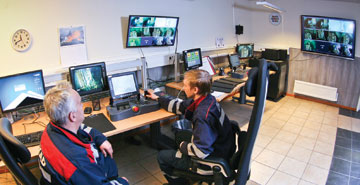 The Malmberget control room, where each operator is in charge of two Simba drill rigs.
The Malmberget control room, where each operator is in charge of two Simba drill rigs.
When it comes to developing state-of-the-art technology for the mining and minerals sector, the Nordic countries unquestionably punch above their weight. Companies that initially built up expertise in providing the machines needed by domestic markets have grown both organically and through acquisition, such that now there are few mining operations worldwide where equipment from one of the Nordic suppliers is not to be found.
As these companies have grown, they have often followed their markets by establishing subsidiaries that can provide equipment and service “on the doorstep,” so to speak. Sometimes this has come about by acquiring a holding in a local enterprise that was already in a particular market, leading perhaps to a subsequent full take-over. In other cases, Nordic companies have invested directly in new production facilities in a target country, following earlier export success. Whatever the reason, today Nordic equipment suppliers are represented throughout the world with a range of factories, agencies and service organizations, all supported by design and engineering expertise from their home country.
Think of the equipment used in a “typical” underground hard-rock mine: drills, bits, charging systems, loaders, haulers, drainage pumps, even level-to-level hoists. Nordic companies can supply them all, together with blasthole drills for surface mines, vehicle lighting systems, and emissions-compliant engines to power machines ranging from mobile crushers to stand-alone generators and heavy-duty haulers.
Think of the equipment needed to recover metals from often low-grade ores, and transform them into usable commodities: crushers, mills, flotation systems, thickeners, filters, pipework, valves, furnaces and fume-collectors. Nordic companies can supply them all, and can make sure that equipment being sent by land or sea arrives safely, on time. Add to these a raft of specializations in areas such as exploration technologies, wastewater treatment, industrial chemicals and environmental protection, and it is clear to see that while the Nordic region makes up only a small proportion of the wider world, its mining-sector suppliers have a lot to offer.
New Horizons for Automated Drilling
It has been a busy year for Atlas Copco’s underground mining division, including acquisitions and a range of new product launches—as well as the company celebrating its 140th birthday. It began with its purchase of the Swiss equipment company, MEYCO, bringing shotcreting expertise to the Atlas Copco portfolio. It followed this with an agreement with MEYCO’s former owner, BASF, to cooperate on future developments in sprayed concrete chemistry and equipment technology.
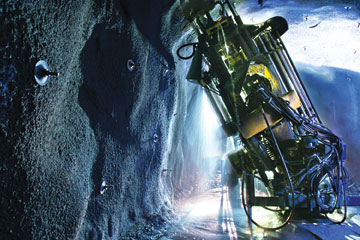 Six new Atlas Copco Simba WL6 C rigs are drilling in the Alliansen orebody at LKAB’s Malmberget mine.
Six new Atlas Copco Simba WL6 C rigs are drilling in the Alliansen orebody at LKAB’s Malmberget mine.
The company took the opportunity provided by the Bauma show in Germany to launch five new products for underground mining. These included the 40-kW COP 4038 rock drill for 43 mm to 64 mm drifter holes which, Atlas Copco claims, drills 20%-30% faster than its nearest competitor and is optimized for hard-rock conditions. Meanwhile, the COP 1800-plus drill series extends recommended service intervals by 50%. An updated Rig Control System was also featured, as was the new Underground Manager for drill rig planning and reporting. The company also introduced its fully dry drilling system on the Boomer XE3 C three-boom jumbo, which uses compressed air for hole flushing and a suction nozzle around the drill string to eliminate dust.
This was followed by the launch of the company’s Green Line of electric-powered underground loaders and trucks. The electric loader range now consists of the EST2D, EST3.5, EST14 and EST1030 Scooptrams, while the two electric trucks are the 35-mt capacity EMT35 and 50-mt EMT50. Power for tramming the electric LHDs is provided by the Gentrail GT325 portable generator.
For diesel-engined equipment, Atlas Copco has introduced Cummins Tier 4i engines as an option for its ST7, ST7LP, ST1030, ST1030LP and ST14 Scooptrams, and for the MT2010 underground truck. Benefits include lower ventilation requirements and fuel savings, the company said.
Drilling automation has been a major development area for the company over many years, with its Simba W462 rigs being introduced first at LKAB’s Kiruna mine, then at Malmberget in 1997. These in turn have been replaced with the latest Simba WL6 C rigs, which are equipped for fully automated, teleremote operation using a new interface and data system.
In the sub-level caving system used at Malmberget, 8- to 10-hole upward fans are drilled 3- to 3.5-m apart, with 102 mm-115 mm holes being drilled up to 47-m long. The Simba rigs are fitted with Wassara water-powered hammers to achieve minimum hole deviation over these lengths. Each fan blast generates around 6,600 mt of ore.
Each of the six rigs is expected to drill 2,100 m a week, with fully automated, unsupervised drilling during night shifts. The teleremote system allows the rigs to be operated with the aid of continuous video supervision and a laser guidance system up to 6 km from the underground control room, with the rigs being equipped with motion sensors that immediately shut them down if someone gets within 2 m of the machine.
Company-wide, recent equipment orders have included the supply of LHDs, trucks and drill rigs to Hindustan Zinc for its Rampura Agucha, Zawar and Kayad mines in India, drill rigs for First Quantum Minerals Cobre Panama copper project, and drill rigs and loaders for Minerven in Venezuela.
Metso Equipment for Finnish Gold Mines
With its wide range of crushing, screening and mineral-processing equipment, Metso reported that it has been one of the leading suppliers to the new generation of gold producers that is building up in the Nordic region. Two of these in particular are Nordic Mines Laiva operation in northern Finland and Endomines Pampalo mine in the east of the country.
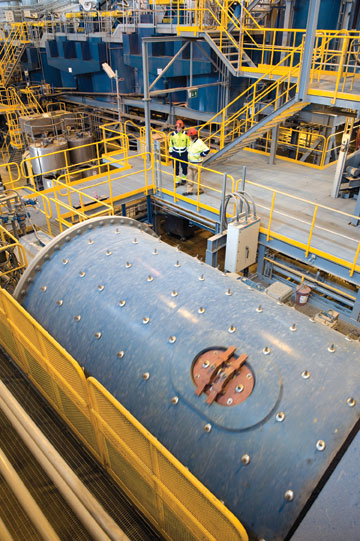 One of the Metso mills at Endomines Pampalo gold plant.
One of the Metso mills at Endomines Pampalo gold plant.
Currently with a throughput capacity of 1.2 million mt/y of 1.6 g/t gold ore at Laiva, Nordic Mines produced 931 kg (29,900 oz) last year from selective open-pit mining. Equipment supplied to the operation by Metso includes a jaw crusher, two cone crushers, two vibrating feeders, a ball mill, a flash-flotation unit, a number of conveyors and more than 70 slurry pumps of various types and sizes.
Endomines Pampalo operation is in the Karelian gold belt. With Metso having designed and supplied a state-of-the-art processing plant, Pampalo runs an environmentally “green” operation that avoids acid mine drainage and targets 100% water recirculation.
Endomines commissioned Pampalo in early 2011 at a cost of some €20 million. Last year it mined 250,000 mt of ore grading 4 g/t, and produced 867 kg (27,860 oz) of gold. It has recently completed a plant expansion project that has lifted nameplate capacity up to 420,000 mt/y.
While the main ore source at Pampalo is underground, Endomines has been evaluating a number of satellite deposits along the gold belt. Since these all lie within 30 km of the existing operation, ore will be trucked for processing at the plant there. In its most recent quarterly report, the company noted that overburden removal and trial mining at the Rämepuro satellite mine is under way, with full-scale mining expected to begin there next year.
According to Endomines CEO Markus Ekberg, the company has shown that even small-scale gold mining and production can be done in a sound and profitable way. Its construction strategy was to divide the work up into small, separate contracts, with Metso supplying the main minerals-processing system. “By doing this, we succeeded in constructing the mine well within the budget and planned schedules. The start-up of the Metso processing plant also went well. Our mine achieved a process utilization rate of more than 90% within two months,” Ekberg said.
The gold at Pampalo is hosted in green schist, and is recoverable using gravity and flotation. Since no cyanide or acid is needed, the tailings pond contains clean, potable water, with full process-water recirculation. “Thanks to Metso’s grinding and processing technology, our gold production has been successful, with more than 85% gold recovery,” Ekberg added.
The plant expansion has included the installation of a second grinding mill and more flotation cells, with the higher throughput meaning that lower-grade ore from the satellite deposits can be handled successfully.
Low Emissions and Fuel Efficiency
According to Volvo Penta, the Volvo group’s sales channel to the external engine market, world-leading OEMs are already signing supply agreements for its Tier 4 final off-road diesel engines, with deliveries starting in 2014. The company used this year’s bauma show to launch its complete Tier 4f 5-16 liter off-road engine range, which uses SCR (selective catalytic reduction) technology to meet the new emission requirements. “We currently have strong growth in the off-road segment, and it is satisfying that our new product program has been so well received in the market,” said Volvo Penta CEO Björn Ingemanson, at the time. “The engines’ fuel efficiency and superior cost of ownership are appreciated by more and more customers.”
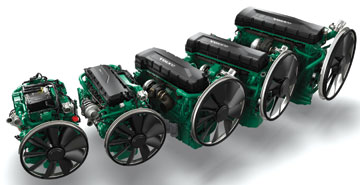 Volvo Penta’s Tier 4f-compliant engines will be available next year.
Volvo Penta’s Tier 4f-compliant engines will be available next year.
Since Volvo Penta introduced its first SCR engines in 2006, users have benefited from increased power and 5%-10% lower fuel consumption, the company stated. In addition, the catalytic converter is designed to last the life of the engine, so there has been no increased demand in terms of service intervals, or additional downtime.
As noted in the July 2013 edition of E&MJ (pp.46-52), Volvo Penta is now offering a complete range of engines approved for underground mining applications. The nine Tier 2-compliant and nine Tier 4i engines provide power outputs in the 224-357 kW (300–479 hp) and 410-522 kW (551–700 hp) ranges, respectively. They also offer industry-leading ventilation demand of around 30 cfm/hp that the company claims is the maximum ventilation rate available for a conventional diesel engine.
Having already introduced as standard a heavy-duty cabling harness for its engines that are used in harsh, dusty working environments, this year Volvo Penta will also be launching the option of a heavy-duty cooling package for these units. The systems are targeted at applications such as stone crushers and screens, air compressors and other off-road equipment that works under conditions involving vibration and dust, with the aim of improving engine uptime and reducing the total cost of ownership.
The company recently received an order from Sandvik for engines to power the new UH450E track-mounted tertiary crusher. As this is driven electrically rather than with an on-board diesel, power comes from a TAD1651GE power-generation engine that is installed in a soundproof container. Not only does this cut noise emissions, but also improves the crushing unit’s energy efficiency, Volvo Penta stated.
Helping Prevent Downtime on Earthmovers
The Danish supplier of oil-flushing and filtering equipment, C.C.Jensen, has expanded its product portfolio with a series of heavy-duty filters, adapted to be installed in the tough and challenging mining environment. Tests have shown that the payback time on offline oil filters for equipment such as dump trucks and excavators is extremely short, the company said, with the potential to make considerable savings by preventing breakdowns and downtime.
 A CJC heavy-duty offline oil filter unit.
A CJC heavy-duty offline oil filter unit.
C.C.Jensen estimates that 80% of breakdowns are related to contaminated oil, and as most equipment has to work around the clock, the cost of a breakdown caused by water or dirt can, in a worst-case scenario, easily exceed $100,000. The new CJC heavy-duty filters offer a solution, with the company stating that they have proved their worth in the roughest conditions where machines have been subject to heavy vibration and shocks. Mobile equipment such as excavators, dump trucks and drill rigs can now operate for much longer without the risk of breakdown if they are equipped with offline filters for diesel, hydraulic and lubricating oils.
Tests with CJC oil filters on excavators have proved that after more than 6,000 hours, hydraulic oil is still cleaner than new oil, whereas oil without filters typically has to be changed after 1,5002,000 hours. The design of the new heavy-duty filters has been based on field trials done in cooperation with customers in Canada, Chile, Australia and South Africa, and C.C.Jensen pointed out that mining companies such as Anglogold Ashanti, Anglo American, BHP and Rio Tinto use its oil filters on mining equipment supplied by OEMs including Caterpillar, Hitachi, Atlas Copco and Sandvik.
While C.C.Jensen filters have been used effectively on stationary equipment in the past, the company has now expanded its market into mobile machines by fitting parts such as anti-vibration mountings. The electric motor has also been made more dust- and water-proof, while the filter insert has a very high dirt-holding capacity, so minimizing maintenance costs.
“Reliable machinery requires clean oil and a clean oil system,” said C.C.Jensen sales manager Bjørn Martinsen. “We are often seeing payback times of less than a year in mining applications, while the solution has a positive impact on the environment,” he added. “Mining companies are focusing more on environmental issues, and these filters represent a small investment but produce significant results in this context.”
Top-performance Drilling Tools
With its home in Finland and a presence in more than 90 countries, Robit Rocktools specializes in top-hammer and DTH drilling tools. The company pointed out that since its roots lie in hard Scandinavian granite and the Finnish mining industry, it has an intimate knowledge of drilling in the most challenging rock types.
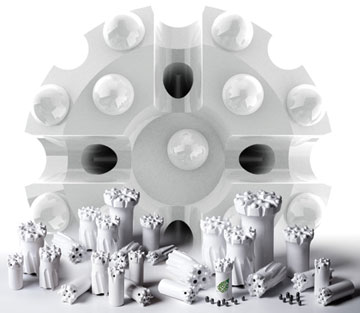 Robit Rocktools offers a complete range of bits for drill-and-blast operations.
Robit Rocktools offers a complete range of bits for drill-and-blast operations.
Robit Rocktools’ product line covers all construction, quarrying and mining drill-and-blast applications, from the softest to the hardest rock conditions. Tunneling is one of its most important customer segments, together with applications such as drifting and bolt-hole drilling. Its portfolio encompasses products such as drifting and tunneling bits, reaming equipment, bench and production drilling bits, rods, shanks, couplings, auxiliary tools such as grinding cups, button bits, and guide adapters.
The company has recently introduced a completely new range of carburized rods, up to 6,400-mm (21 ft) long for underground drilling. It has also launched new DS (drop center with straight body) and DSR (drop center with retrac body) series of mid-size button bits. Covering 60- to 92-mm hole diameters, these bits have extended lifetimes and give faster penetration, Robit said.
Building Rock-reinforcement Capabilities
The Finnish company Normet specializes in equipment used in underground mining for shotcrete transport and spraying, highly mechanized explosives charging, and materials logistics. It also markets the chemical admixtures used in shotcrete production and spraying.
At the beginning of this year, the company bought the Norwegian rock-support technology specialist, Dynamic Rock Support (DRS), thereby adding the energy-absorbing D-Bolt system to its rock reinforcement product portfolio. A spin-out company from the Norwegian University of Science and Technology, DRS was founded in 2008 with the focus of providing reliable support technology for underground mines, particularly where challenging ground conditions involve squeezing or dynamic risk management. The D-Bolt is a rock bolt specifically designed to provide rock reinforcement in squeezing and burst-prone strata.
At the time, Normet’s president Tom Melbye said, “With the D-Bolt system, together with our sprayed concrete, grouting and injection technologies and products, we can now help our customers to make underground mines and tunnels safer, even in difficult strata and high stresses and deformations.” DRS is one of two companies representing Norway in the 2013-2014 European Business Awards competition, which focuses on companies that exhibit the highest levels of innovation, business excellence and sustainability.
Normet’s product line encompasses equipment used to mechanize scaling, shotcrete transport and spraying, explosives charging, lifting and access, materials and personnel logistics. It also has the Semmco shotcrete product line for the Latin American market, together with its TAM International range of shotcrete and construction chemical additives.
Flexibility from Scania
The Swedish truck manufacturer, Scania, said it is using experience gained during more than a century in the heavy vehicle industry to provide a range of solutions for global mining companies. Besides specialized mining trucks, it can supply buses for crew transport and engines to power mining equipment and generator sets, as well as container-based field workshops for on-site servicing, and training for drivers and service staff. Customization is a key element here, with Scania working with individual customers to design an appropriate response to their requirements.
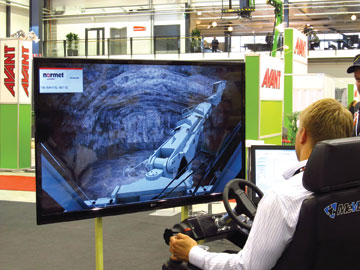 Normet’s scaler simulator, shown at EuroMining 2013. (Photo by Simon Walker)
Normet’s scaler simulator, shown at EuroMining 2013. (Photo by Simon Walker)
Scania noted that transport in and from a mine often makes up 30%-60% of total operating costs. Rising fuel prices have put fuel consumption on everyone’s agenda, while the industry is challenged by volatile commodity prices and lower ore grades in many major deposits. As a result, the company said, secondary deposits are becoming increasingly interesting. However, these smaller operations (and extensions to existing mines) often have longer transport routes to the processing plant. This in turn provides an advantage for smaller, less-expensive “road trucks” that are considerably more fuel-efficient than larger haulers.
Scania vehicles are available for every stage in a mining project, from exploration to reclamation. Used for on-site transport, trucks of the size that Scania offers can operate on narrow haul roads that are less expensive to build and maintain, while providing extra flexibility in terms of capacity. For off-site haulage, they can run on public roads if required. Its rigid dump trucks offer capacities up to 46 mt while Scania road trains for, say, concentrate haulage, can carry up to 120 mt.
The company points out that its vehicles and components are based on modular designs that use around 30% fewer parts than the industry average. This makes for significantly easier servicing and parts supply, as well as facilitating the recruitment and training of mechanics and technicians. Its field workshops use a modular container system that can quickly be brought into service.
Scania offers driver training, which may help save fuel as well as cut vehicle wear and tear, as well as tailored financing, leasing and rental solutions. In addition, it offers advisory services in logistics, transport planning, road economics and operational monitoring which, it said, can often contribute to improved production flows and increased productivity.
Steel for High Wear Applications
Finland’s leading steel-maker, Ruukki, has recently added to its range of Raex wear-resistant steels. Raex can withstand wear and surface pressure, with the range having been expanded to include the thicker wear-resistant steels needed in the mining industry, according to the company.
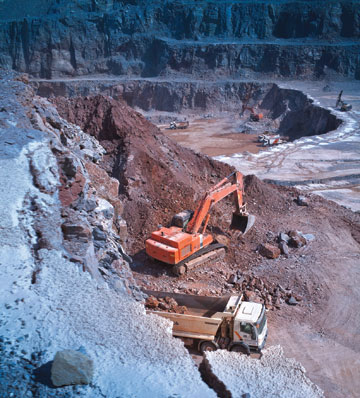 Ruukki’s Raex wear-resistant steels help to extend the service life of mining equipment, according to the company.
Ruukki’s Raex wear-resistant steels help to extend the service life of mining equipment, according to the company.
Now made in thicknesses from 2 to 80 mm, Raex can be used to manufacture parts for heavy machinery and equipment designed for digging, loading, transporting and crushing ore. Applications include excavator and front-end loader buckets, tipper bodies for heavy earthmoving machinery, conveyor systems, crushers, silos and hoppers. The thinner grades in the Raex family have already been used for years in the transport industry and other applications where strong, wear-resistant steel is needed, Ruukki stated.
The company claims that the consistent quality of its Raex steels significantly prolongs equipment lifetimes, giving cost and competitiveness benefits for the end user. Choosing the optimum thickness of steel in the manufacture of buckets and tipper bodies, for instance, can help to reduce the overall weight of the equipment itself. This can increase the payload, which in turn benefits fuel consumption.
Ruukki explained that its Raex steels have been developed together with its customers, and have excellent cutting, bending and welding properties. Made using a direct-quenching method that both improves the properties of wear-resistant steels and makes them consistent in quality, Raex steels have a hard surface and strong microstructure, the company added.
Saving Energy with AC Drives
Positioning itself as the world’s largest independent drives company, Vacon’s AC drives are finding increasing numbers of applications in the mining and metal industries. Its products provide accurate and reliable speed and torque control for conveyors, crushers, grinding mills and other electrical motor-driven equipment, with its NXP and NXC AC drives offering the kind of high power production required for heavy material haulage and critical flow control, the company said.
According to Vacon, running AC motors with variable-speed drives instead of constant or fixed speeds can save up to 50% in energy consumption, especially when operating pumps, fans, compressors and winches. AC drives are also much quieter than traditional hydraulic alternatives, and motors can be run up to three times faster than with hydraulic systems in applications such as slack rope handling. Vacon offers a complete product portfolio in the power range 0.25 kW to 5 MW, including air and liquid-cooled units and common DC bus components. Step-up medium voltage solutions are also available.
One example of its equipment in use, cited by the company, is at Yamana Gold’s Fazenda Brasileiro gold mine in northeast Brazil. Vacon’s AC drives were selected for the underground mine’s ventilation and pumping systems in a large retrofitting project. Fan speeds are controlled using the AC drives according to real demand, which saves energy.
In Western Australia, meanwhile, Vacon has supplied some of its NXC low-harmonic drives to the Greenbushes lithium mine. In an expansion project there, Automation Alliance, one of Vacon’s partners, was responsible for selecting and commissioning all the drives on site. Automation Alliance selected two NXC drives to control the new primary and regrind ball mills. Its principal electric engineer, Malcolm Barnes, said, “I was impressed with the drives’ design and performance. The modular design of the active front-end module is identical to that of the inverter module, which reduced the cost of holding spares on site for the customer. The communication interface also made it easy to integrate the drives into the plant control system.”
Overall, Vacon estimates that the use of its AC drives worldwide helped save around 50 TWh of energy in 2012—roughly equivalent to 20 hours of the world’s annual electrical energy production. The company stated that payback times for AC drives have continuously shortened, such that in pump and fan applications it can now be less than one year.
Grindex’s Next-generation Pumps
Grindex launched an updated range of drainage and sludge pumps at this year’s bauma exhibition. These pumps deliver increased running time and require less maintenance, which reduces the total cost of ownership, the company stated.
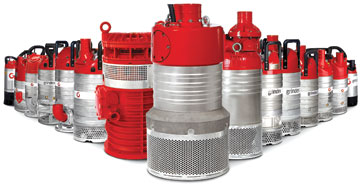 Grindex says that its submersible pumps cover drainage, sludge and slurry-handling in the most challenging environments.
Grindex says that its submersible pumps cover drainage, sludge and slurry-handling in the most challenging environments.
A world leader in electrical submersible pump technology, Grindex was founded in 1940 and since 1960 has been specializing in pumps for drainage, sludge and slurry applications. Built-in motor protection and an air valve mean that its pumps can run unsupervised for long periods, and even run dry for a length of time. The company exports to more than 100 countries and has a U.S. subsidiary.
In the new range, the Minex, Minette, Minor, Major, Master and Matador drainage pumps and the Salvador, Senior and Sandy sludge pumps have all been updated to deliver improved pumping performance, while the need for maintenance and spare parts has been reduced, Grindex reported. The updated pumps now have a new seal design with a robust metal housing that offers improved heat transfer and sealing function for a longer life.
The pumps now comprise fewer parts, which reduce the risk of leakage and speeds up maintenance. A new lifting handle and a deeper groove in the strainer also mean that they are more ergonomic, while the Minor, Major, Senior and Sandy have new lifting eyelets for hooks. In addition, dry-running performance has been improved with the introduction of more and better air valves, and a larger oil volume.
Improved hard-wearing features include new wear-resistant impellers for the Minex and Minette drainage pumps, a wear-resistant coating of polyurethane for all sludge pumps and a polyurethane option for the Minor to Matador drainage pumps. A further safeguard measure is the proven SMART motor protection, which cuts the power if the temperature gets too high or if it loses a phase. SMART also ensures the impeller turns in the right direction.
“At Grindex we are continuously working to develop our solutions,” said technical engineer, Jonas Bladh. “Many of the changes in this latest generation of pumps are based on conversations with our customers and field engineers. We’ve listened to what they have to say, and where an improvement could be made, we’ve made it.”
Improving Availability using Guided Troubleshooting
From its headquarters in Aalborg, Denmark, Dezide provides knowledge management systems for optimizing technical troubleshooting processes in the mining industry. The company specializes in tools for maintenance troubleshooting on heavy equipment, and on industrial rotating equipment such as electric motors, pumps, gearboxes and fans.
Users are guided through the troubleshooting process in a structured way, Dezide explained. Dezide Advisor can be used for on-site troubleshooting by field service engineers; for remote troubleshooting and guidance by surveillance-center staff; for automated diagnostics, monitoring, prediction and alerts based on live data from machinery and equipment; and as self-service troubleshooting tools for mine operators and engineers. By finding the most likely root cause, the system helps to minimize the overall cost and time of repair.
Dezide claims that Advisor operates well even in situations with missing, uncertain or conflicting input, and is easily integrated with SCADA and monitoring systems to include sensor data, error messages and other automated data readings in the troubleshooting process.
Its troubleshooting guides can be integrated with live data such as the last error codes produced by the machine controller, machine operating hours, engine hours, hydraulics information and so on, removing the need for manual evaluation of complex data.
The company gave a business case example for a mining excavator, such as an RH120E, in iron ore production. With a 2% increase in annual availability and lower unplanned downtime by using Advisor, the machine stands to produce additional ore worth some $3 million, it said. Used across a whole mining fleet, the Dezide solution could provide a positive ROI within a few months, it added.
Dezide handles the complete flow from machine breakdown, trying to resolve the issue remotely, to dispatching an engineer who continues the troubleshooting session on-site.
On-site disconnected troubleshooting ensures access to the knowledge base at all locations, even in remote mining environments. An online knowledge base for monitoring-center staff, integrated with various data sources, provides a quick overview of the situation and informed suggestions for problem resolution.
Other benefits include increased availability as problems are fixed faster, increased reliability, the potential for fewer mistakes to be made, lower costs as fewer spares are needed, less staff training, improved knowledge sharing, and the opportunity to identify faulty service processes and components, Dezide said.
Water-powered Drilling Boosts Ore Production
A leader in water-powered DTH drilling, LKAB Wassara has a seven-model range of hammers that cover hole sizes from 60 mm to 254 mm (2½ to 10 in.). Wassara hammers normally use up to 300 l/min of clean water at a pressure of up to 180 bar.
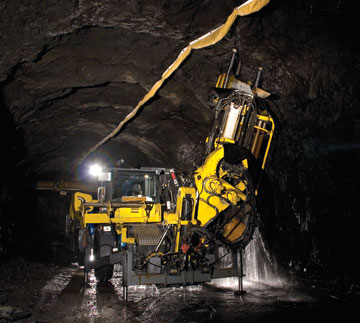 All of LKAB’s production drilling is now done using Wassara water-powered hammers.
All of LKAB’s production drilling is now done using Wassara water-powered hammers.
The company stated that water’s incompressibility means that the system can achieve higher efficiency, higher pressure and lower losses than traditional air-powered hammers. Hole sizes can be reduced, since the drilling accuracy is much greater, Wassara added, with water power giving consistently high drilling efficiency no matter what length the hole is. In addition, the company pointed out, a high-pressure water pump is much more energy-efficient than an air compressor, so energy consumption is reduced.
According to Wassara, when LKAB scaled up its production in 1990, it needed a drilling technology that could provide 60-m long blast holes with a maximum deviation of 1.5%, and at a lower energy cost. This was the challenge that led to the development of water-powered drilling, such that today, all production drilling at LKAB is done using Wassara’s waterpowered DTH hammers. Thus far, the company added, a total of 18 million m (59 million ft) of blastholes have been drilled using Wassara technology at LKAB’s Kiruna and Malmberget mines.
Although LKAB has relied on sub-level caving throughout its history, 1990 marked a step change in its requirements. In order to increase iron-ore production, the vertical distance between sub-levels was more than doubled from 12 m to 28 m, with the longest blastholes jumping from 28 m to 56 m in length. This cut the amount of sub-level development needed by 70%, while the output per blast increased from 1,200 mt in the 1980s to the 10,000 mt achieved at Kiruna today.
The use of longer blastholes also brought a new requirement for increased drilling accuracy and hole straightness. Good fragmentation of the rock depends on minimal deviation of the blastholes from the design pattern, with Wassara reporting that its hammers meet LKAB’s requirement for 1.5% maximum deviation day-in, day-out.
Today, LKAB’s production drilling involves holes up to 56-m long, depending on the shape of the ore body. The penetration rate achieved is 0.5 to 1 m/minute with 115 mm drill bits, with media holes and slots also being drilled using the Wassara system. A typical installation uses a Wassara W100 hammer fitted to a 115-mm drill bit, working on Atlas Copco or Sandvik drill rigs, with clean water being handled by pumps supplied by either Kamat or Hammelmann.
Creating Optimal Logistics Solutions
Based in Esbjerg, Denmark, Blue Water Shipping is an international shipping, transport and freight-forwarding company. It has more than 60 offices worldwide that handle transport and logistics solutions for all types of cargo and for all destinations. The company stated that its team of experts has years of experience within worldwide transport and logistics for the mining industry, and that it offers a wide variety of services focusing on Africa, Greenland, Canada and Australia where an increasing number of mining projects are under way.
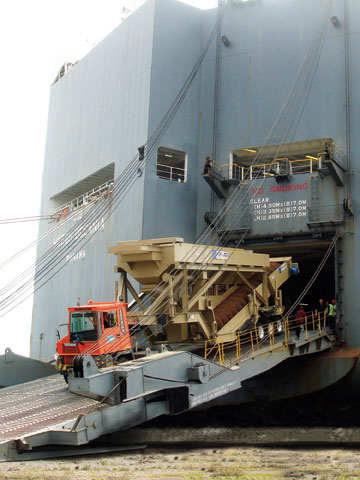 Mobile mineral-processing equipment being handled by Blue Water Shipping.
Mobile mineral-processing equipment being handled by Blue Water Shipping.
“We emphasize on personal service using our on-site experience with loading/unloading operations, consulting and pre-shipment surveys and inspections,” Niels Mikkelsen from the company’s mining projects division told E&MJ. “With expert insights of the industry, Incoterms and planning of multiple transport solutions we meet and exceed our clients’ expectations,” he added. “Our services also include project management and full track and trace of all shipments, ensuring a reliable handling of mining equipment.”
In-house specialists from Blue Water Shipping includes stevedores, port captains, naval architects and HSSEQ (health, safety, security, environment and quality) specialists, ensuring quality all the way. Being used to handling challenging project cargo and being a part of a flexible international organization, Blue Water Shipping is proactive in creating the optimal solutions to any challenge along the way, Mikkelsen stated.
Exploration Drilling in a Sensitive Environment
One of the largest exploration drilling contractors in the Nordic region, Oy Kati specializes in diamond core drilling. Its goal is to provide its mining and exploration industry clients with high-quality geological data in an efficient and reliable manner. In addition to drilling, it carries out down-hole surveys using state-of-the-art equipment, thereby providing its clients with valuable additional data. Kati’s headquarters are located in western Finland.
Kati noted that it has extensive experience working in demanding conditions, from underground mines to high-altitude sites, and from arctic regions to the Sahara desert. Its operations have been based on sustainable development principles for years, and comply with the ISO 14001 environmental management standard.
With its diamond core drilling and surveying, Kati said it produces high-quality core and other information in an efficient and trustworthy manner. Its client base consists of various major and junior exploration and mining companies, as well as the dimension-stone industry, environmental research institutes, power companies, the Geological Survey of Finland, municipalities and other public-sector organizations.
By using deviation surveys, drill-hole locations can be located extremely accurately in 3-D. This is essential information for a company planning mining activities, as it determines precisely from where each piece of core in the core box has been recovered. Kati claims to offer the widest selection of deviation survey tools, including surveys using real north-seeking gyros to give the most reliable survey results.
The company has designed and built its own modern core-drilling units that are efficient, suitable for all kinds of terrain, minimize any environmental impact and provide safe, comfortable working conditions. Kati can also provide underground rigs and helicopter-transportable rigs. Nearly all its rigs are rubber tracked, which makes moving easier and minimizes any stress on the environment, while its closed-circuit drilling system saves up to 75% of the water being used and simplifies cuttings separation.
Sandvik: Automation and Energy-saving Focus
From the U.S., Sandvik reported that it recently worked with the Wyoming-based coal producer, Cloud Peak Energy, on field trials for its high-pressure compressor management system (CMS) for its blasthole drill rigs. The CMS tackles the two primary issues facing mines today—increasing productivity and reducing environmental impact—by providing a solution to the inherent inefficiencies of rotary blasthole drills that have a direct connection between the engine and the compressor. It works by isolating the compressor and eliminating the need to maintain pressure when the machine is not drilling. This reduces the load on the engine, saving a significant amount of fuel and reducing engine wear, Sandvik said.
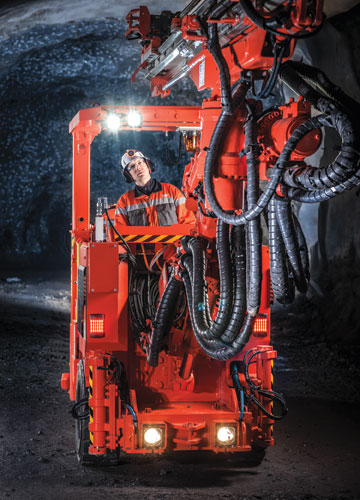 The DD211 has been designed for good maneuverability in narrow-vein mines.
The DD211 has been designed for good maneuverability in narrow-vein mines.
Initial trials on a retrofitted DR460 drill at the Drayton coal mine in New South Wales produced 33% fuel savings, according to Sandvik. For the Cloud Peak trial, the CMS was retrofitted to a 14-year-old D75KS rotary rig that had already run up nearly 60,000 hours. While Sandvik had initially estimated there would be a 23% fuel saving, results showed that the figure was more than 26%, equivalent to annual cost savings of more than $100,000 and some 300 mt of carbon emissions. Cloud Peak Energy subsequently bought two new Sandvik rigs with CMS installed, the company reported.
In early September, Sandvik used the opportunity provided by its international customer day in Tampere, Finland, to introduce new drill rigs and drilling tools, as well as marking the official launch of the two underground mine trucks that were featured in the June edition of E&MJ
(p. 57). For underground mining, the company unveiled its DD422i Axera and DD211 development drill rigs, while its surface-mining drill range has been extended with the introduction of the new Pantera DP2000 top-hammer rig.
The electro-hydraulic DD422i is the first of the company’s next generation underground hard-rock drill rigs, and was described by Ulla Korsman-Kopra, vice-president for underground development drills, as offering industry-leading levels of safety, productivity and automation. “It provides a clear direction to the future of mining, incorporating a wide variety of new features for more efficient drilling,” she said. Scheduled for introduction to the market next year, the DD422i includes an intelligent control system that is ready for tele-remote operation using Sandvik’s AutoMine Drilling system.
A twin-boom rig, the DD422i can cover a 10.3- × 6.6-m (34- × 22-ft) face area. Tramming power comes from a 119-kW Cummins Tier 3 or 4f-compliant diesel.
Meanwhile, the DD211 is a single-boom electro-hydraulic development rig for narrow-vein applications, featuring safety upgrades from its predecessor, plus more automation. A key feature is its ability to negotiate corners as tight as a 2.5-m radius. Developed primarily for the Latin America, North America and CIS markets, the rig uses Sandvik’s THC561 electro-hydraulic control system, covering constant-speed drilling controls, stop-and-return automatics and air-mist flushing with rock-drill return.
The Pantera DP2000 is the top-hammer version of the rig exhibited at the EuroMining show (See pp.66-69). With a distinctive new-look, Sandvik said it has developed the new Pantera range to take advantage of mining industry trends toward fully autonomous operation—with options that allow owners to take advantage of automation technology as their needs and mining operations change. Equipped with the company’s new RD2045C hydraulic top-hammer drill, and designed to use 20-ft (6.1-m), 127-mm-diameter drill tubes, the DP2000 can drill 152-mm to 178-mm-diameter holes 36-m deep.
New drill tools launched in September included the RH460 range of DTH hammers, with the 4-in. and 5-in. versions available now, and 3.5-in., 6-in. and 8-in. units still to come.






